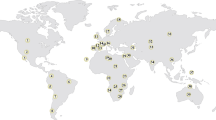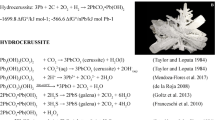Abstract
The fast, high-throughput distinction between paleoanthropological remains and recent forensic/clinical bone samples is of vital importance in the field of medicolegal science. In this paper, a novel screening method has been described, using the crystallinity index (C.I.) and carbonate–phosphate index (C/P) as a means to distinguish between archeological and forensic anthropological skeletal findings. According to the Fourier transform infrared spectroscopy analyses, the archeological bone samples are characterized by a range of C.I. between 2.84 and 3.78 and by low C/P values of 0.10–0.33, while the C.I. and C/P ranges of forensic skeletal remains are 2.55–3.18 and 0.38–0.88, respectively. Significant (p < 0.05) changes were observed in C/P as well as C.I. values between the groups of forensic and archeological skeletal samples. The suggested dating method needs only a few milligramms of bone tissue; thus, it can be extremely useful for distiguishing ancient and recent bone fragments.



Similar content being viewed by others
References
Boskey AL, Camacho NP (2007) FT-IR imaging of native and tissue-engineered bone and cartilage. Biomaterials 28:2465–2478
Nagy G, Lorand T, Patonai Z, Montsko G, Bajnoczky I, Marcsik A, Mark L (2008) Analysis of pathological and non-pathological human skeletal remains by FT-IR spectroscopy. Forensic Sci Int 175:55–60
Miller LM, Vairavamurthy V, Chance MR, Mendelsohn R, Paschalis EP, Betts F, Boskey AL (2000) In situ analysis of mineral content and crystallinity in bone using infrared micro-spectroscopy of the ν4 PO4 3− vibration. Biochim Biophys Acta 1527:11–19
Introna F Jr, Di Vella G, Campobasso CP (1999) Determination of postmortem interval from old skeletal remains by image analysis of luminol test results. J Forensic Sci 44:535–538
Ramsthaler F, Kreutz K, Zipp K, Verhoff MA (2009) Dating skeletal remains with luminol-chemiluminescence. Validity, intra- and interobserver error. Forensic Sci Int 187:47–50
Piga G, Malgosa A, Thompson TJU, Enzo S (2008) A new calibration of the XRD technique for the study of archaeological burned human remains. J Archaeol Sci 35:2171–2178
Surovell TA, Stiner MC (2001) Standardizing infra-red measures of bone mineral crystallinity: an experimental approach. J Archaeol Sci 28:633–642
Thompson TJU, Islam M, Piduru K, Marcel A (2011) An investigation into the internal and external variables acting on crystallinity index using Fourier transform infrared spectroscopy on unaltered and burned bone. Palaeogeogr Palaeoclim Palaeoecol 299:168–174
Gourion-Arsiquaud S, Faibish D, Myers E, Spevak L, Compston J, Hodsman A, Shane E, Recker RR, Boskey ER, Boskey AL (2009) Use of FTIR spectroscopic imaging to identify parameters associated with fragility fracture. J Bone Miner Res 24:1565–1571
Thompson TJU, Gauthier M, Islam M (2009) The application of a new method of Fourier transform infrared spectroscopy to the analysis of burned bone. J Archaeol Sci 36:910–914
Pucéat E, Reynard B, Lécuyer C (2004) Can crystallinity be used to determine the degree of chemical alteration of biogenic apatites? Chem Geol 205:83–97
McLaughlin G, Lednev KI (2011) Potential application of Raman spectroscopy for determining burial duration of skeletal remains. Anal Bioanal Chem 401:2511–2518
Howes JM, Stuart BH, Thomas PS, Raja S, O’Brian C (2007) An investigation of model forensic bone in soil environments studied using infrared spectroscopy. J Forensic Sci 57:1161–1167
Trueman CN, Privat K, Field J (2008) Why do crystallinity values fail to predict the extent of diagenetic alteration of bone mineral? Palaeogeogr Palaeoclim Palaeoecol 266:160–167
Weiner S, Bar-Yosef O (1990) States of preservation of bones from prehistoric sites in the near east: a survey. J Archaeol Sci 17:187–196
LeGeros RZ (1981) Apatites in biological systems. Progr Crystal Growth Charact 4:1–45
Shemesh A (1990) Crystallinity and diagenesis of sedimentary apatites. Geochim Cosmochim Acta 54:2433–2438
Stiner MC, Kuhn SL, Weiner S, Bar-Yosef O (1995) Standardizing infra-red measures of bone mineral crystallinitiy: an experimental approach. J Archaeol Sci 22:223–237
Wright LE, Schwarcz HP (1996) Infrared and isotopic evidence for diagenesis of bone apatite at Dos Pilas, Guatemala: palaeodietary implications. J Archaeol Sci 23:933–944
Kjell J (1997) Chemical dating of bones based on diagenetic changes in bone apatite. J Archaeol Sci 24:431–437
MacFadden BJ, Labs-Hochsteina J, Quitmyera I, Jone DS (2004) Incremental growth and diagenesis of skeletal parts of the lamnoid shark Otodus obliquus from the early Eocene (Ypresian) of Morocco. Palaeogeogr Palaeoclim Palaeoecol 206:179–192
Squires KE, Thompson TJU, Islam M, Chamberlain A (2011) The application of histomorphometry and Fourier transform infrared spectroscopy to the analysis of early Anglo-Saxon burned bone. J Archaeol Sci 38:2399–2409
Rogers K, Beckett S, Kuhn S, Chamberlain A, Clement J (2010) Contrasting the crystallinity indicators of heated and diagenetically altered bone mineral. Palaeogeogr Palaeoclim Palaeoecol 296:125–129
Acknowledgments
The present work was supported by the Hungarian National Scientific Research Foundation (OTKA No. K72592, CNK78480, PD78599), TÁMOP-4.2.1.B-10/2/KONV-2010-0002, TÁMOP/SROP-4.2.2.B-10/1-2010-0029, TIOP 1.3.1-10/1-2010-0008, TIOP 1.3.1-07/1, GVOP 0179, and PTE AOK KA 34039-11/2009 and KA 2011. The authors thank the excellent technical support to Sajti Pinter Krisztina.
Ethical standards
The authors declare that the experiments comply with the current laws of Hungary and the European Union.
Conflict of interest
The authors declare that they have no conflict of interest.
Author information
Authors and Affiliations
Corresponding author
Rights and permissions
About this article
Cite this article
Patonai, Z., Maasz, G., Avar, P. et al. Novel dating method to distinguish between forensic and archeological human skeletal remains by bone mineralization indexes. Int J Legal Med 127, 529–533 (2013). https://doi.org/10.1007/s00414-012-0785-4
Received:
Accepted:
Published:
Issue Date:
DOI: https://doi.org/10.1007/s00414-012-0785-4




